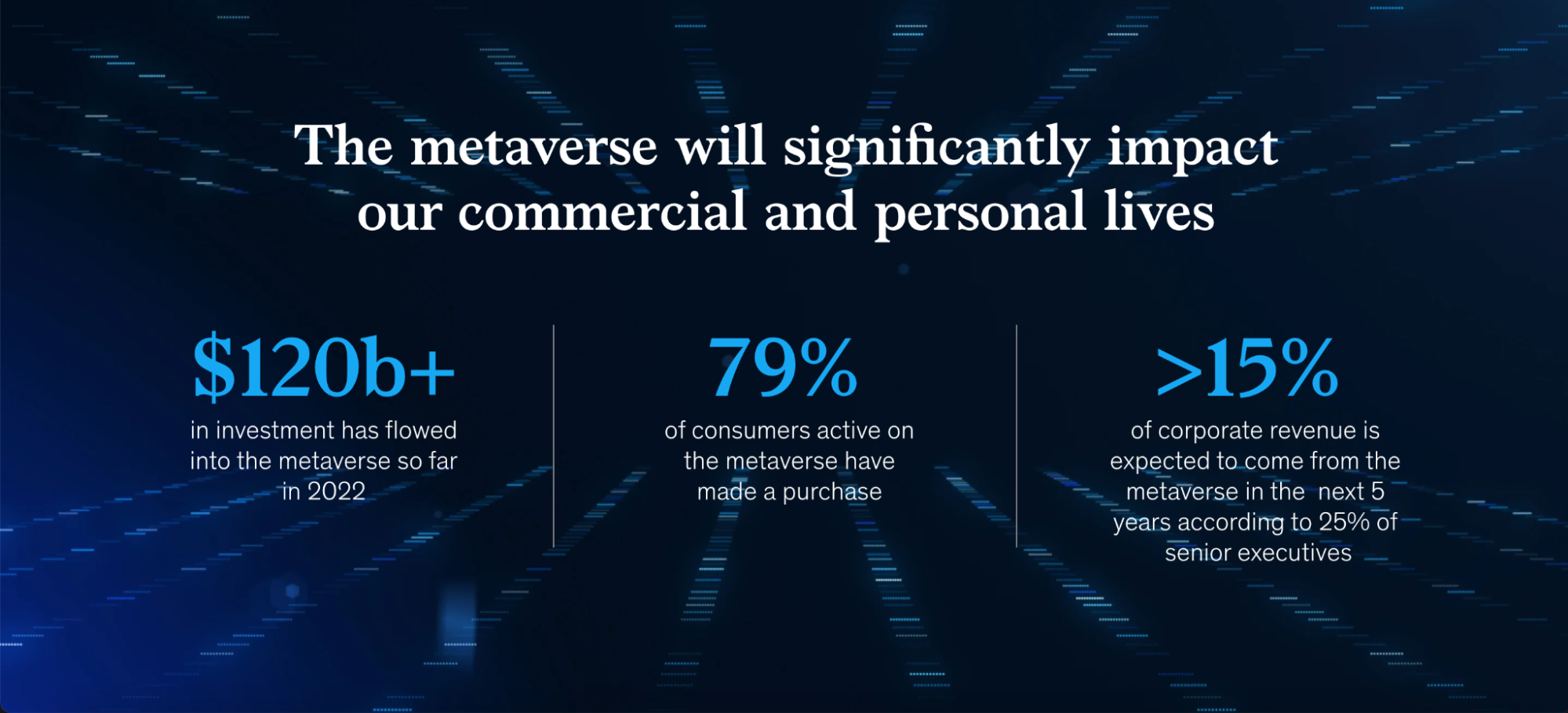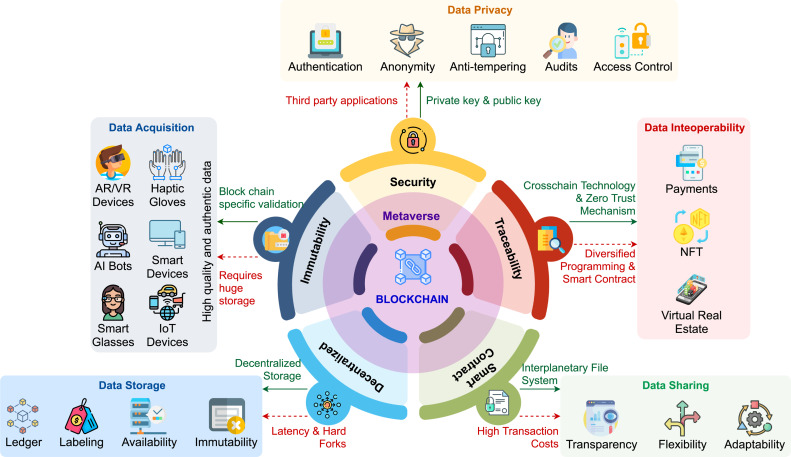Table of contents
- “Metaverse” meaning
- What does the metaverse consist of?
- Infrastructure and hardware
- Content and experiences
- Platforms
- Enablers
- How does the metaverse work?
- Metaverse technology
- What does the metaverse look like now?
- Gaming
- Training
- Digital twin avatars
- Duplicating physical spaces
- Collaboration in the workplace
- 3D in media
- How is the metaverse accessed?
- Is it safe to be in the metaverse?
- What is the difference between the Internet and the metaverse?
- Why does the metaverse involve holograms?
- What does gaming have to do with the metaverse?
- When is a fully-fledged metaverse coming?
- How will the metaverse affect the future?
- Are there metaverse risks?
- Use the metaverse with caution
“Metaverse” meaning
You’ve probably heard about the “metaverse.” Everyone is talking about it. Big tech is investing in it. But how do you define it, exactly, and what’s the hype about?
Metaverse definition
You can explain the metaverse as an intangible, 3D experience that mimics the world that you exist in. It comprises virtual reality and mixed reality, which means it can be accessed using technology—specifically, a headset or a browser.
Think of the metaverse as a second life that closely resembles your current one. It exists alongside the real world—you can work, buy clothes, and even buy land and properties in the metaverse. You exist in the form of an avatar and can engage with other real people in the form of avatars.
But it isn’t just limited to individuals—businesses can also exist in and benefit from the metaverse by selling digital products to customers and making money in the real world. In fact, a McKinsey report reveals that at least $120 billion had been invested into the metaverse by 2022. McKinsey research also reveals that the metaverse could be worth $5 trillion by 2030. That’s in less than a decade from the time of writing.

Talking about the metaverse is like trying to understand the internet when it wasn’t a thing decades ago. You understand the implications—you know it’s a big deal and that it will change life as you know it. However, it’s a hard concept to grasp due to it being a new thing. It isn’t crystal clear what it is, exactly. So stay with us to be able to fully comprehend what metaverse is.
What does the metaverse consist of?
The metaverse is a multifaceted world with many moving parts. Below is a list of things you can find in the metaverse.
Infrastructure and hardware
The metaverse is powered by infrastructure and devices that allow participants anywhere in the world to communicate in real-time. The infrastructure and devices enable virtual interactions and new ways to transact, earn, and buy digital assets.
For example, cryptocurrency is the currency used in the metaverse. It’s a digital asset, which makes it easier to use across experiences in the digital space of the metaverse. Accessories, devices, and operating systems are some examples of infrastructure and hardware that exist in the metaverse.
Content and experiences
The metaverse places a large focus on immersive experiences and activities.
Gaming
Gaming platforms Roblox and Unity are focusing on user-generated 3D video games. Industry giants like Epic Games and Unity are investing in metaverse experiences. However, games will be more immersive than they are at present.
Social experiences
People will be able to socialize using their avatars in the metaverse. Part of this involves attending events like parties with other avatars, much like you already do in real life.
Immersive commerce
The metaverse offers nuanced shopping experiences. In 2018, Shopify designed a consumer experience using virtual reality and augmented reality.
Collaborations
In the metaverse, colleagues are able to collaborate in more immersive ways through existing technologies. Remote workers can split into teams during a meeting. Employees can use mixed reality headsets to help them multitask when they’re busy. Live events can be used for team buildings, events, and social purposes. The point is to mimic the office experience for remote and hybrid workers.
Platforms
There are multiple metaverse platforms available. We’ve listed some popular ones below:
- Meta Horizon Worlds and Horizon Workrooms. Meta (previously known as Facebook or FB) CEO Mark Zuckerberg chats about Meta’s vision for the metaverse quite a lot. Meta’s Horizon is a “social universe" where friends can spend time together. Workrooms, on the other hand, is Meta’s professional iteration of the metaverse. It’s a mixed-reality app for staff collaborations
- Roblox. Roblox is focused on empowering people to create their own experiences. Creators can come up with their own games and interact with games created by other people
- Sandbox. Sandbox is an interactive gaming platform built on the Ethereum blockchain. It doesn’t have a goal, but players can set their own goals as they wish
- Nvidia Omniverse. This is a virtual, 3D-focused platform. It allows individuals and teams to work on Universal Scene Description-based workflows and applications
- AltspaceVR. AltspaceVR is a virtual reality events platform that allows hosts to have shows, classes, and meet-ups. In 2017, Microsoft acquired AltspaceVR and joined its Mixed Reality division.
Enablers
What are the technologies that support the metaverse?
- Virtual reality (VR) and augmented reality (AR). These are the technologies that give birth to the devices used to access the metaverse, like VR headsets
- Artificial intelligence (AI). AI technology is responsible for creating engaging and interactive experiences and features that make the metaverse inclusive and accessible for all who engage in it
- 5th generation networks (5G). In the metaverse, users can interact from different ends of the world. It’s because of 5G technology that this is possible
- NFTs and crypto-assets. NFTs and crypto-assets are the currency by which those transactions are facilitated, as well as trading and other activities
- Apps and tools. Apps and tools that help facilitate transactions, make monetization possible, and manage digital identity play an important role in the metaverse.
How does the metaverse work?
The metaverse is still a work in progress, so there’s no consensus on how it works. But here’s what we know: Blockchain-based decentralized finance tools, real-time collaboration software, and 3D technology will power the metaverse. Tech ecosystems like Apple and Android have limited interoperability and seek to establish their dominance.
Metaverse technology
There are many technologies that form part of the metaverse. We’ve listed seven of these technologies below:
- Blockchain. Most applications in the metaverse run on blockchain technology, which allows developers to add the necessary functions in the metaverse

- AI. Artificial intelligence helps in the creation of realistic avatars, images, environments, and dialogue in the metaverse
- Cryptocurrency. Users can buy digital real estate and NFTs in cryptocurrency to transact in the metaverse
- 3D modeling and reconstruction. Businesses in the eCommerce space are increasingly turning to 3D models and reconstruction technology to offer users virtual showroom tours and property showings. That’s because 3D technology produces experiences that closely resemble reality
- Internet of Things (IoT). IoT devices connect the metaverse to the physical world, which will allow users to have real-time interactions. It will share data between the two worlds, which will enhance the user experience and make it seamless
- AR and VR. AR and VR technologies allow users to have truly immersive experiences in the metaverse. The combination of these two technologies creates more realistic experiences
- 5G and edge computing. Both 5G and edge computing contribute to smoother experiences in the metaverse. Due to the affordability and accessibility of 5G, more users can access the metaverse.
What does the metaverse look like now?
Various industries have already tapped into and started actively using the metaverse.
- Gaming
- Training
- Digital twin avatars
- Duplicating physical spaces
- Collaboration in the workplace
- 3D in media
Gaming
Online gaming has produced immersive gaming experiences for years. Epic Games, Roblox, and Decentraland are just some of the gaming platforms that players flock to in the metaverse.
Training
Some businesses use the metaverse as part of their training. Likewise, hospitals have also started using it for training purposes. Surgeons who just completed their studies can perform surgery in the metaverse as part of their training before applying their skills in the real world to a human being.
Digital twin avatars
Digital twin avatars are avatars of real people in the metaverse. These are used in several applications, depending on whom the avatar belongs to. For example, the music entertainment industry has been using holograms of deceased artists to continue their legacy by performing at musical concerts.
But digital twin avatars can also be used by businesses whose leaders are public figures. For example, a CEO’s AI-powered hologram can be used to attend events in the metaverse.
Duplicating physical spaces
In addition to digital twin avatars, business spaces can be duplicated in the metaverse. A simple example would be duplicating a factory to learn more about how things are made. In some cases, this may be an easier solution than peeling back the layers in a physical building.
For example, retailer Forever21 partnered with Roblox to let customers shop for exclusive clothing items in custom stores in a place called Shop City.
Collaboration in the workplace
Zoom users can use 3D virtual avatars that mimic their head movements to make meetings more fun. Businesses can set up dynamic 3D rooms that employees can explore in the metaverse.
Some companies have embraced the new way of working and opted to enhance the remote or hybrid work experience for their employees. The metaverse can be seen as a way to add value, keep staff engaged, and improve collaboration.
3D in media
Media companies use 3D simulation. Israeli-based AI video maker Hour One created a 3D news studio simulation that lets users choose a news anchor (avatar) to deliver the news. Ian Beacraft, a contractor for news broadcast company, DeFiance Media, uses 3D simulation to create media content for the broadcaster. The simulation platform used by Beacraft allows users to input factors such as an avatar’s camera angles and what the avatar news anchor should say.
How is the metaverse accessed?
The metaverse can be accessed through VR, AR, browsers, and mobile devices.
- VR is a simulated 3D experience by which we experience a virtual environment that mimics reality using our senses. To access this virtual environment, users wear VR headsets that catapult them into a new virtual world. Gloves, body-tracking suits, and vests can be worn to give users a more life-like experience
- AR is a toned-down, less realistic version of VR. Pokémon Go would be considered AR. Users in AR environments can still engage with their physical environment. Google Glass is an AR product
- Browsers and mobile devices are used to access gaming platforms, including Roblox, Minecraft, and Decentraland.
The best way to become part of the metaverse is to buy the relevant hardware. It typically doesn’t come cheap, although you could start with something like Google Cardboard, which costs $15.
A mid-range option would be Meta’s Oculus Quest 2 headset, which starts at $400. This headset is a popular pick among VR enthusiasts. If you have more money to throw around, consider the Valve Index VR, which can set you back $999.
Is it safe to be in the metaverse?
Given that the metaverse exists within the Internet, you run the risk of exposing your data and personal information when you’re part of it. Therefore, you must protect yourself in the metaverse the same way you do when using the Internet for anything else.
The metaverse is an immersive experience, so the hardware you use to access it collects data like your eye movements, hand movements, and more. When you enter the metaverse from your home, your surroundings are recorded. This means that your privacy can be compromised.
Protect your data and personal information as much as possible by using a VPN at all times. Clario’s desktop VPN service hides your IP address to keep you anonymous online, preventing Internet service providers (ISPs), advertisers, hackers, and cybercriminals from spying on you.
Here’s how to use Clario’s VPN tool:
- Download Clario on your computer and set up an account
- Click VPN in the left pane and click the Turn on button
- Clario will connect you to the location with the best server at the time. However, you have the option of picking a different location. Simply click the location above the button and choose your preferred location from the extensive list.

Tip
Keep Clario’s VPN tool enabled at all times to stay protected against cybercrime 24/7 and remove the pressure of remembering to turn it on.
What is the difference between the Internet and the metaverse?
You probably engage with and use the Internet daily without much thought. Typically, you use the Internet with a mobile phone, laptop, or computer, and connect using the internet. You don’t need any unique devices to use the Internet. Additionally, there’s a clear distinction between you as the user and the platform you’re interacting with on the Internet. The metaverse works differently.
Instead of being a separate user, you’re immersed in the experience of a metaverse platform. You’re a part of it, as opposed to being a separate user. While you can access metaverse games in your browser, some metaverse experiences require specialized gear, like headsets and glasses.
When using the Internet, you can read about experiences and even watch related videos. The metaverse, on the other hand, allows you to participate in experiences. For instance, you can watch a music concert on YouTube, but you can attend one virtually in the metaverse for a more personal experience.
The key difference is that you’re a user of the Internet but a participant in the Metaverse, which is the point. The metaverse is supposed to resemble reality as closely as possible.
Why does the metaverse involve holograms?
The whole point of the metaverse is for businesses to showcase or offer their solutions and contributions to the technology of the future. However, the dilemma with metaverse technology has often been how people interact with said technology.
For instance, VR headsets are clunky and uncomfortable. They aren’t the most practical devices, especially when worn for long periods. They don’t seamlessly blend into your everyday life—there’s a time and place for them. The same applies to AR glasses.
That’s where holograms come in. Holograms are fictionalized impressions of what the future could look like in the metaverse. At least, that’s what the likes of Meta and other players in the metaverse believe. However, tech companies have yet to perfect holograms. For now, it seems avatars make the most sense for representing people in the metaverse.
What does gaming have to do with the metaverse?
The gaming industry was one of the early adopters of the metaverse. Online gaming, in particular, has been shifting toward the metaverse. Games have been immersive for years—that’s why players get lost playing online games for hours. But next-generation gaming is even more realistic.
Gaming in the metaverse is a perpetual gaming experience. Instead of switching a game on or off, you enter the space and become a part of it. The experience remains even when you’re done playing.
And gaming is as real as it gets in the metaverse, especially in multiplayer games. Players can interact with each other and use haptic items like gloves and jackets to enhance their experiences. They can also trade assets. What makes gaming special in the metaverse is that players can make real money when they sell virtual assets via NFTs.
When is a fully-fledged metaverse coming?
The metaverse is still years away. For one, metaverse technologies and devices aren’t easily accessible to everyone. In 2021, Bill Gates predicted that businesses would experience the metaverse fully sooner than individuals, as virtual meetings move to 3D spaces.
A survey by Pew Research Center and Elon University's Imagining the Internet Center asked tech experts, leaders, developers, researchers, and more about their thoughts on the adoption of the metaverse by 2040. 54 percent said they expect the metaverse to be a well-functioning, refined, and immersive aspect of the daily life of 500 million people or more globally. 46 percent didn’t expect this to be the case.
How will the metaverse affect the future?
Given that the metaverse is still a work in progress, it will really be interesting to see how it fleshes out in the future. As far as the workplace is concerned, the metaverse will enhance collaboration. Virtual meetings and presentations will no longer be boring and redundant.
Employees will be able to walk around a room to get comfortable and even split up into groups as they would in person. It could add a whole new dimension to remote meetings and conferences—it could make them less dreadful.
As such, the metaverse will likely be an extension of your life and lifestyle.
Are there metaverse risks?
As with all things relating to the Internet, there are privacy and cybersecurity risks associated with the metaverse. There is no regulation for the metaverse, which poses a challenge for users.
While the General Data Protection Regulation (GDPR) protects the privacy of European users, it can be incorrectly applied in the metaverse. Organizations will have to tread carefully and implement policies to protect users’ data and privacy to avoid getting in trouble with the law.
As for individuals, the risks are many:
- Bullying is a huge concern, as it remains an issue on the Internet, especially for minors
- The high cost of equipment needed
- Privacy violations and security breaches
- Addiction.
Use the metaverse with caution
The metaverse is an exciting place for tech enthusiasts. It’s rich with immersive experiences, and people and businesses in various industries can benefit from it. However, there are privacy and security concerns that come with being part of the metaverse. Protect your privacy with Clario’s VPN to reduce the chances of bad actors spying on you online. Always use the Internet and technology with caution.


